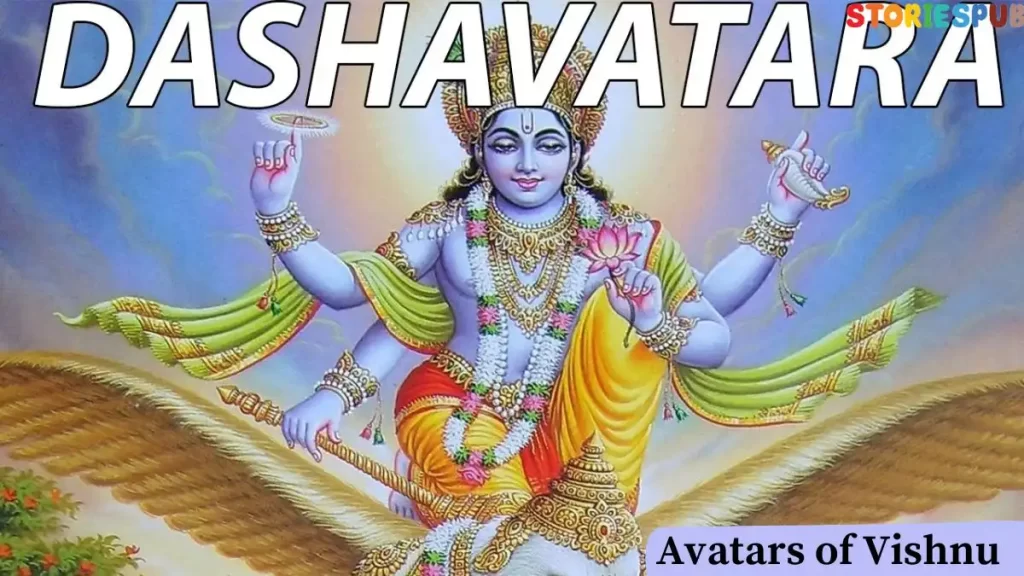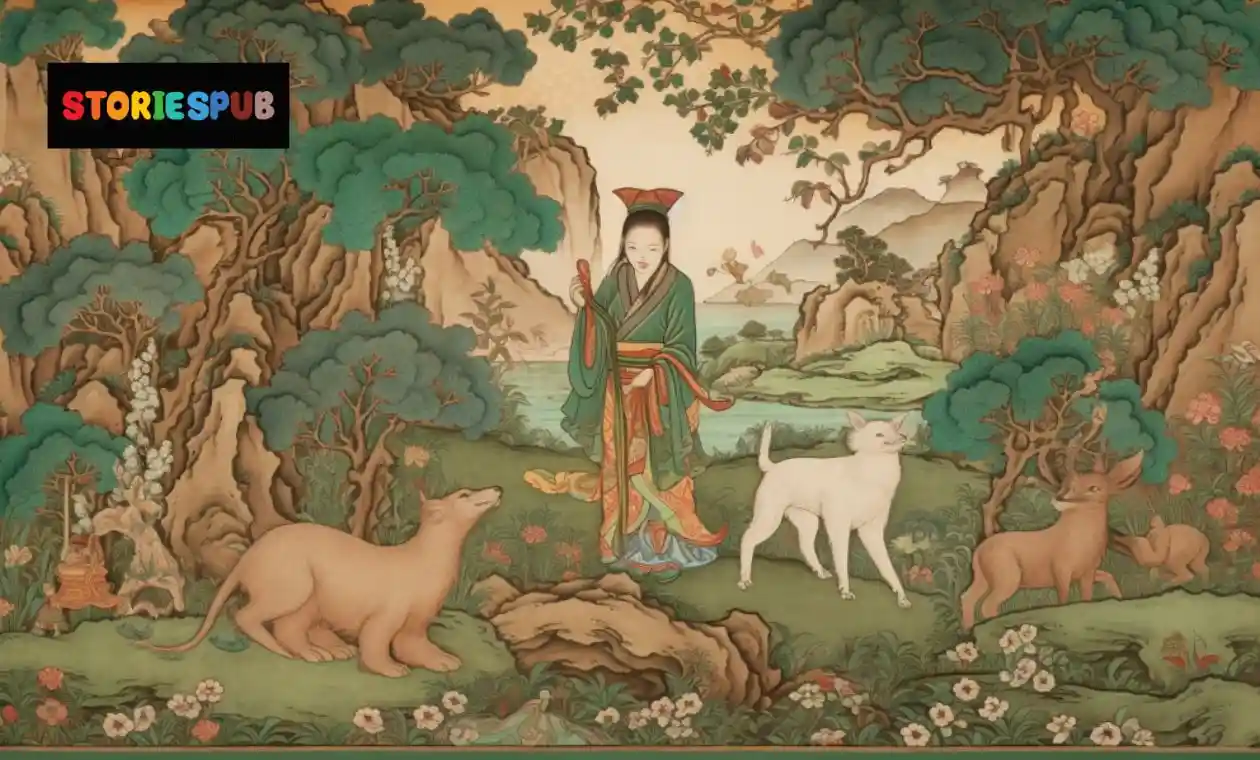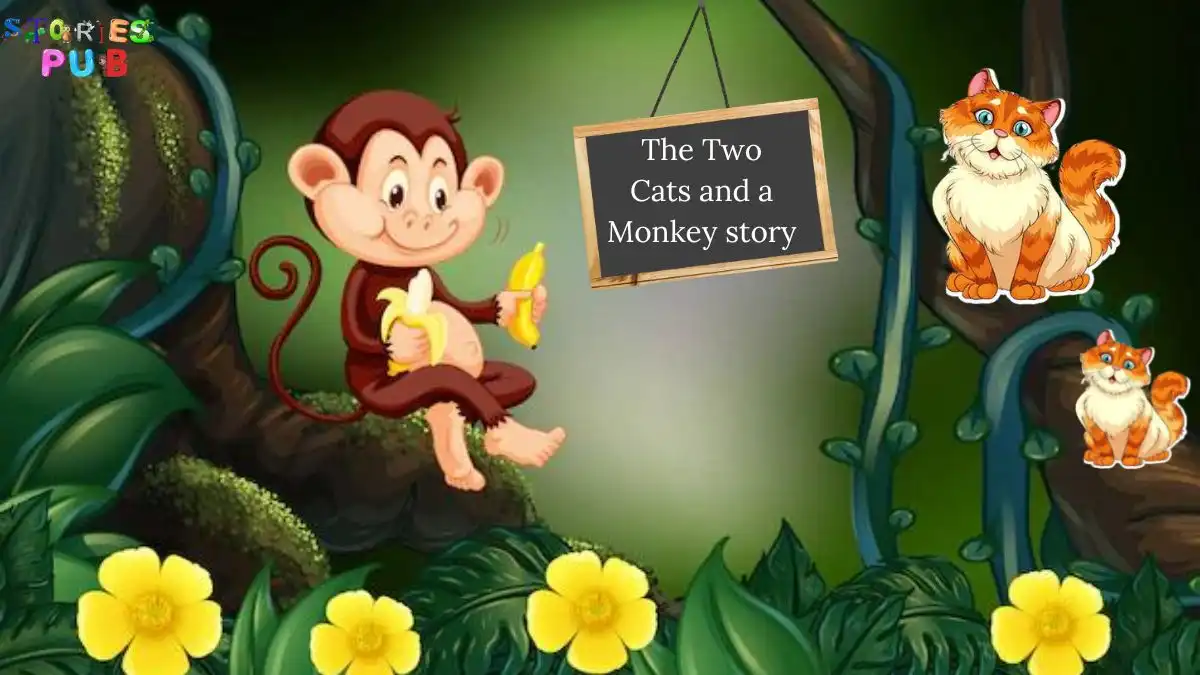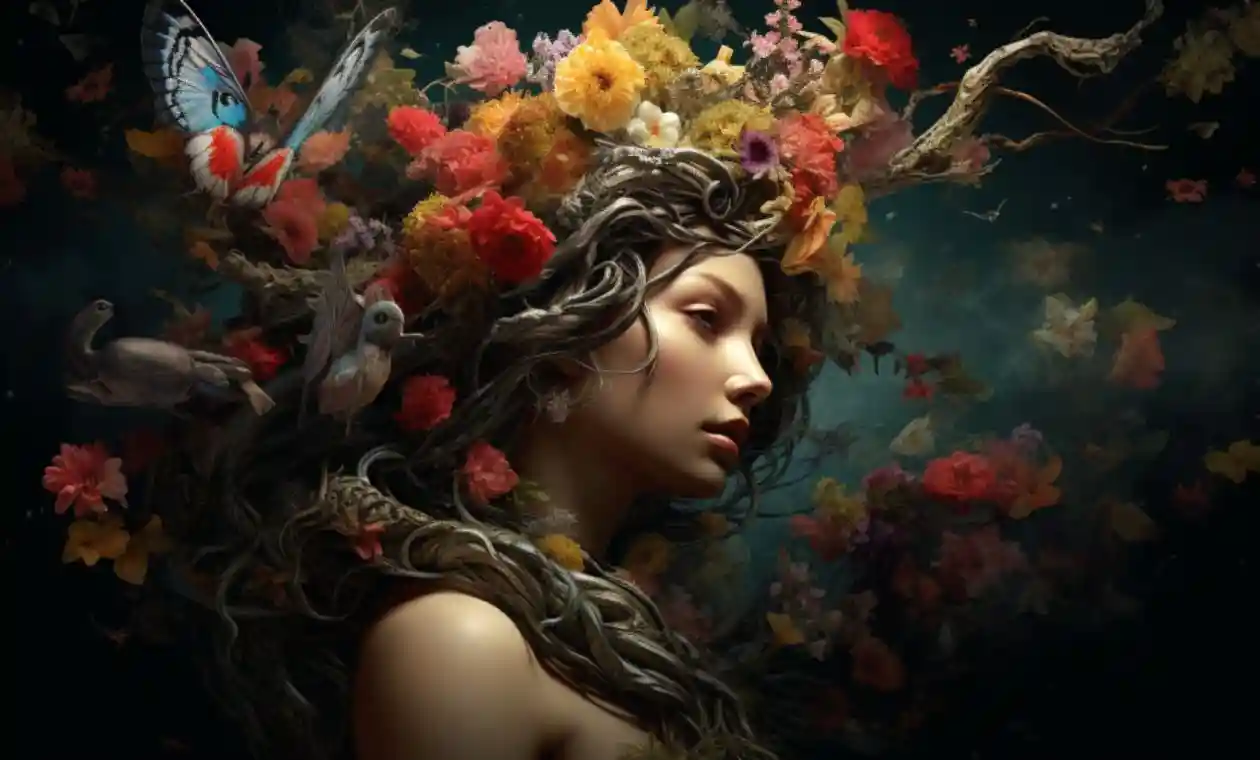The 10 Avatars of Vishnu: Stories of Evolution

Once upon a time, in the cosmic realms beyond human understanding, there was the supreme deity, Lord Vishnu. Vishnu, one of the principal deities in Hinduism, was known as the preserver and protector of the universe. He was responsible for maintaining balance and order in the world. When the balance was threatened, and chaos reigned, Vishnu would descend to Earth in different forms, known as avatars, to restore harmony and protect the innocent.
The concept of Vishnu’s avatars is deeply rooted in Hindu mythology, with the avatars representing various aspects of life and the natural world. They also signify the evolution of life on Earth, from aquatic creatures to complex human beings. It is said that Vishnu takes ten primary avatars, known as the ‘Dasavatar,’ to maintain order in the universe.
The first avatar of Vishnu was Matsya, the fish
In ancient times, when the Earth was still young and the balance between good and evil was fragile, there lived a wise and pious sage named Manu. Manu was devoted to Lord Vishnu, the preserver and protector of the universe, and spent his days in prayer and meditation. One day, while Manu was performing his ablutions in the river, he noticed a tiny fish struggling against the current. Filled with compassion, Manu scooped the fish into his hands and decided to save it.
To his amazement, the fish began to speak to him. “O wise Manu, I am no ordinary fish. I am an incarnation of Lord Vishnu, and I have come to warn you of a great deluge that will soon engulf the world. This flood will wipe out all life on Earth and erase all knowledge that humanity has accumulated.”
Manu listened intently as Matsya, the fish-avatar of Vishnu, continued, “You must build a great ark, large enough to house all the species of plants, animals, and humans that exist on Earth. Gather the sacred texts, the Vedas, and the seeds of every plant and tree, so that they may be preserved during the flood. I will guide you through the tumultuous waters and ensure your safety during this catastrophic event.”
Humbled by this divine revelation, Manu immediately set to work building the massive ark. As the days passed, he collected the sacred texts and seeds, along with pairs of every animal and bird. He toiled tirelessly, driven by his unwavering faith in Vishnu’s guidance.
Finally, the day of the great deluge arrived. Dark clouds filled the sky, and torrential rains began to pour down, flooding the Earth. As the waters rose, Manu, along with his family and the creatures he had gathered, boarded the enormous ark. True to his word, Matsya appeared once more, this time as a colossal fish with gleaming scales and a powerful tail. He instructed Manu to tie the ark to his horn using the great serpent Vasuki as a rope.
The storm raged on for days, submerging the Earth beneath the swirling waters. But Manu’s faith in Vishnu never wavered, and with Matsya’s guidance, the ark remained afloat amidst the chaos. Eventually, the storm abated, and the waters began to recede. The ark came to rest on the peak of Mount Himavan, the highest mountain range in the world.
As the Earth slowly dried, Matsya led Manu and the creatures down from the mountain, allowing them to repopulate the world and rebuild civilization. Manu disseminated the sacred texts and the knowledge they contained, ensuring that the wisdom of the ages would not be lost.
Thus, Lord Vishnu, in the form of Matsya, the fish, saved humanity from the great deluge and restored balance to the Earth. The story of Matsya serves as a reminder of the divine intervention that occurs when the world is threatened and the importance of unwavering faith in the face of adversity. Through his devotion and trust in Vishnu, Manu played a pivotal role in preserving life and knowledge, allowing future generations to thrive and flourish.
The legend of Matsya highlights the cyclical nature of creation and destruction, emphasizing the need for balance and harmony in the universe. It also teaches us the importance of protecting and preserving the knowledge and wisdom that humanity has acquired, as these are the foundations upon which civilizations are built and sustained.
In a broader sense, the Matsya avatar symbolizes the power of transformation and adaptability, as Vishnu assumes an entirely new form to overcome the challenges that threaten the world. This theme of transformation is echoed throughout the other avatars of Vishnu, reminding us of the boundless potential and resilience that exists within each and every one of us.
As we continue to share and cherish the story of Matsya and the great deluge, we honor the divine intervention that saved humanity and the Earth. We are reminded of the significance of faith, courage, and determination in overcoming adversity and preserving the balance and harmony that are essential to our existence.
The second avatar, Kurma, a giant tortoise
Long ago, in the celestial realms, the gods and demons found themselves locked in a great struggle. Seeking the nectar of immortality, or amrita, they realized they would have to work together to churn the vast ocean of milk, the Kshira Sagara. The amrita lay hidden at the bottom of this cosmic ocean, and it could only be obtained by stirring the waters with such force that it would rise to the surface.
The gods and demons devised a plan to churn the ocean. They decided to use Mount Mandara, a towering peak that reached into the heavens, as the churning rod. To provide the necessary force, they enlisted the help of Vasuki, the great serpent king, who would act as the rope to turn the mountain. As the gods grasped Vasuki’s tail and the demons held his head, they began to pull back and forth, setting Mount Mandara in motion.
However, as the churning commenced, a problem arose. The immense weight of the mountain caused it to sink into the ocean, threatening to halt the churning process and jeopardize the quest for amrita. Recognizing the dire situation, Lord Vishnu, the preserver of the universe, decided to intervene.
Assuming the form of Kurma, the giant tortoise, Vishnu dove into the depths of the cosmic ocean. With his massive, sturdy shell, Kurma positioned himself beneath Mount Mandara, providing support and preventing the mountain from sinking further. With the mountain secured, the gods and demons resumed their churning, grateful for the divine intervention that had saved their endeavor.
Vishnu’s third avatar was Varaha, the boar
In a time long past, when the balance between good and evil was threatened once again, the demon Hiranyaksha sought to plunge the world into darkness. Driven by his malicious desires, he hid the Earth beneath the cosmic waters, endangering all life and throwing the universe into disarray.
As the Earth disappeared from sight, the gods grew increasingly concerned, for they knew that without the Earth, the delicate balance that governed the universe would be lost. They turned to Lord Vishnu, the preserver and protector of the cosmos, and implored him to intervene and save the world from this terrible fate.
Vishnu, recognizing the urgency of the situation, took on the form of Varaha, the mighty boar. With his massive size, powerful tusks, and a strong body covered in thick, bristling fur, Varaha was well-equipped to face the challenges that lay ahead. He descended into the depths of the cosmic ocean, determined to find the Earth and restore it to its rightful place.
As Varaha delved deeper into the abyss, he encountered Hiranyaksha, the demon responsible for the Earth’s disappearance. A fierce battle ensued between the colossal boar and the formidable demon, their clashes echoing through the depths of the cosmic waters. Varaha’s immense strength and determination, combined with his divine power, ultimately proved too much for Hiranyaksha. In the end, the demon was vanquished, and the Earth was freed from his grip.
With the demon defeated, Varaha turned his attention to the Earth. He gently lifted it with his mighty tusks and began the journey back to the surface. As he emerged from the cosmic waters, he carefully positioned the Earth back in its rightful place in the cosmos, restoring the delicate balance that had been disrupted by Hiranyaksha’s malevolence.
The gods and all living beings rejoiced at the return of the Earth and the triumph of good over evil. Varaha, the mighty boar, had saved the world from destruction and set the stage for the continued evolution of life.
The story of Varaha holds a profound significance, symbolizing the emergence of life from water and the beginning of the terrestrial phase of existence. It also serves as a reminder of the strength and perseverance needed to overcome adversity, as well as the importance of maintaining the balance that governs our world.
As the third avatar of Vishnu, Varaha teaches us that in times of darkness and despair, divine intervention can come in the most unexpected forms. Through faith and determination, we can conquer the challenges that threaten the harmony of our existence and emerge victorious, just as Varaha did in his battle against the demon Hiranyaksha.
The fourth avatar, Narasimha
In an age long past, the demon king Hiranyakashipu ruled with an iron fist, striking fear into the hearts of both humans and gods alike. Through intense penance, he had obtained a boon from Lord Brahma, which granted him near invincibility. He could not be killed by man or beast, during the day or night, indoors or outdoors, on the ground or in the sky, or by any weapon. Emboldened by his newfound power, Hiranyakashipu sought to subjugate all who opposed him and demanded that he be worshipped as the supreme being.
However, his own son, Prahlada, defied him. A staunch devotee of Lord Vishnu, Prahlada refused to worship his father and instead continued to pay homage to Vishnu, the preserver of the universe. Enraged by his son’s disobedience, Hiranyakashipu subjected Prahlada to a series of cruel punishments in an attempt to break his devotion. Yet, through it all, Prahlada’s faith in Vishnu remained unshaken, and he miraculously survived each of his father’s brutal attempts to end his life.
Witnessing the young boy’s unwavering devotion and the torment he endured, Lord Vishnu decided to intervene. To circumvent the conditions of Hiranyakashipu’s boon, Vishnu assumed a unique form: Narasimha, a being that was half-man, half-lion. This extraordinary creature was neither fully human nor fully animal, and thus could not be considered a man or a beast, allowing him to overcome the restrictions of the demon king’s invincibility.
One fateful evening, at the very moment when day turned to dusk, neither day nor night, Narasimha appeared before Hiranyakashipu and Prahlada. The demon king, unable to recognize the true nature of this fearsome being, arrogantly dismissed him as a mere anomaly.
But Narasimha was undeterred. As Hiranyakashipu approached him, the fearsome half-man, half-lion deity seized the demon king and dragged him to the threshold of a doorway, a space that was neither indoors nor outdoors. Narasimha then placed Hiranyakashipu on his lap, which was neither on the ground nor in the sky, and with a swift movement of his razor-sharp claws, Narasimha tore open the demon’s chest, effectively circumventing all the conditions of his invincibility.
As the lifeless body of Hiranyakashipu fell to the ground, the divine intervention that had saved Prahlada was revealed. The young devotee, his faith stronger than ever, fell to his knees before Narasimha, expressing his profound gratitude for the protection he had received.
The tale of Narasimha, the fourth avatar of Lord Vishnu, is a powerful reminder of the strength of unwavering faith and devotion. It demonstrates that even the most seemingly insurmountable obstacles can be overcome by the divine when the power of love and righteousness prevails. Through righteousness prevails. Through his fierce devotion to Lord Vishnu, Prahlada not only survived the torments inflicted upon him by his father but also became a symbol of the ultimate triumph of good over evil.
The story of Narasimha also teaches us that the divine can manifest in unexpected forms, transcending the limitations of our understanding to restore balance and justice in the world. When faced with adversity, the tale of Narasimha inspires us to remain steadfast in our beliefs and trust in the power of the divine to guide and protect us.
The fifth avatar was Vamana, the dwarf
In a time long ago, the demon king Mahabali ruled over his kingdom with wisdom and benevolence. Under his reign, the people prospered, and peace prevailed throughout the land. His subjects adored him, and his rule was so fair and just that even the gods began to take notice. Although Mahabali was a demon, his noble nature and good deeds earned him the admiration of both humans and gods alike.
However, as Mahabali’s power and influence grew, so did his ambition. He sought to expand his rule, ultimately challenging the dominion of the gods themselves. Alarmed by the threat posed by the demon king, the gods turned to Lord Vishnu for help.
To restore balance and curb Mahabali’s expanding power, Vishnu assumed the form of a small, humble Brahmin named Vamana. He approached the king during a grand ceremony, where Mahabali was bestowing gifts upon his subjects. As Vamana approached, the generous king welcomed him warmly and asked him what he desired.
Vamana made a simple request: he asked for just three paces of land, a seemingly insignificant gift. Confident in his ability to grant such a modest request, Mahabali agreed without hesitation. However, as soon as the king granted his consent, Vamana began to transform. The small, unassuming Brahmin grew into a colossal figure, so enormous that his form filled the sky.
With his first step, Vamana covered the entire Earth. With his second, he spanned the heavens, leaving no realm untouched by his immense presence. As the people and gods watched in awe, it became clear that there was no space left for Vamana’s third step.
Realizing that he had been outwitted by the divine, Mahabali displayed great humility and wisdom. Instead of resisting or expressing anger, the king offered his own head as the place for Vamana’s third step. This selfless act symbolized his complete surrender and submission to the divine will.
Moved by Mahabali’s devotion and humility, Lord Vishnu placed his foot gently on the king’s head, pushing him down to the underworld, but not without granting him a boon. In recognition of his good deeds and the love of his people, Vishnu allowed Mahabali to return to Earth once a year to visit his beloved kingdom and ensure their continued prosperity.
The story of Vamana, the fifth avatar of Lord Vishnu, teaches us valuable lessons in humility, wisdom, and the importance of recognizing the divine even in the most unassuming forms. It also serves as a reminder that unchecked ambition can have consequences, and that true greatness lies in the ability to accept and embrace the will of the divine.
Through this tale, we learn that even the most powerful rulers must ultimately bow to the divine order, and that surrendering to the higher power can lead to redemption and lasting blessings for ourselves and those around us.
The sixth avatar, Parashurama, a warrior sage.
In the age of the gods and demigods, the world was ruled by the Kshatriyas, the warrior class that was entrusted with upholding justice and protecting the innocent. However, as time passed, the Kshatriyas grew increasingly corrupt and oppressive, using their power to dominate and exploit the common people.
Amidst this darkness, the sixth avatar of Vishnu appeared: Parashurama, a warrior sage who wielded an axe as his weapon. He was born into the family of the sage Jamadagni and his wife Renuka. From a young age, Parashurama displayed an exceptional talent for martial arts and became a master of archery, swordsmanship, and hand-to-hand combat.
Driven by a fierce sense of justice and the desire to restore balance to society, Parashurama embarked on a mission to rid the world of the corrupt and oppressive Kshatriya rulers. With his immense strength, mastery of weapons, and unyielding determination, he emerged victorious in numerous battles against the corrupt Kshatriya warriors, defeating them in one-on-one combat and liberating the oppressed people.
As he travelled across the land, Parashurama founded several martial arts schools and passed down his knowledge to future generations. He also established ashrams and temples dedicated to Lord Vishnu and lived the life of a warrior sage, serving as an inspiration to all who sought to uphold justice and righteousness.
Despite his many victories, Parashurama remained humble and dedicated to his duty. His axe, known as the Parashu, became a symbol of his strength and determination, a reminder of his unyielding commitment to the cause of justice and the protection of the innocent.
The story of Parashurama, the sixth avatar of Vishnu, is a testament to the power of righteousness and the unyielding spirit of those who fight for justice and the greater good. It teaches us that even in the darkest of times, a single individual can make a profound difference and that the greatest battles are fought not with physical strength alone, but with an unyielding spirit and a commitment to what is right.
Rama, the seventh avatar
He is the protagonist of the epic Ramayana, which tells the story of his life and adventures. Rama, an embodiment of virtue and righteousness, was a prince who was exiled from his kingdom. Along with his wife Sita and brother Lakshmana, he lived in the forest, where the demon king Ravana kidnapped Sita. Rama, aided by the monkey god Hanuman and an army of monkeys, eventually defeated Ravana and rescued Sita, returning to his kingdom and restoring peace and justice. Rama’s reign, known as Ram Rajya, is considered the epitome of good governance and moral rule.
The eighth avatar, Krishna
Born during a tumultuous time when the evil king Kansa sought to kill him, Krishna was raised by foster parents in the village of Vrindavan. As a child, he displayed divine powers and performed numerous miracles. Later in life, Krishna played a pivotal role in the Mahabharata, the great Indian epic, as the charioteer and advisor to the warrior prince Arjuna. Krishna’s teachings in the Bhagavad Gita, a conversation between him and Arjuna on the battlefield, form the basis of Hindu philosophy and spiritual practice.
The ninth avatar, Buddha
In Hindu mythology, the ninth avatar of Lord Vishnu is a subject of some debate. While most traditions recognize Lord Vishnu’s eighth avatar as Krishna, there are some that believe Gautama Buddha to be the ninth.
The story of Buddha’s connection to Vishnu’s avatars is rooted in the ancient Indian concept of avatars, which refers to the incarnation of a divine being in human form to guide humanity. In this context, Buddha is seen as an embodiment of Vishnu’s teachings of compassion, non-violence, and enlightenment.
According to legend, Gautama Buddha was born as Siddhartha Gautama to a royal family in ancient India. Despite being sheltered from the outside world, Siddhartha became increasingly aware of the suffering and impermanence of human life. This awareness led him to renounce his privileged life and embark on a spiritual journey in search of enlightenment.
After years of meditation and self-reflection, Siddhartha achieved enlightenment under a Bodhi tree, becoming the Buddha or the “awakened one.” He spent the rest of his life spreading his teachings and guiding others towards enlightenment.
The connection between Buddha and Vishnu’s avatars lies in the fact that his teachings embody many of the same principles that are espoused by Vishnu’s incarnations. Like Parashurama, Buddha fought for justice and righteousness, but in a more spiritual sense. He encouraged his followers to cultivate inner peace, wisdom, and compassion towards all beings, regardless of their caste, creed, or social status.
The Buddha’s teachings had a profound impact on ancient Indian society, and his message of compassion and non-violence continues to resonate with millions of people around the world today. As such, his inclusion as Vishnu’s ninth avatar serves as a testament to the enduring power and relevance of his teachings.
In conclusion, while the inclusion of Gautama Buddha as Vishnu’s ninth avatar is subject to debate, his message of compassion and non-violence has had a profound impact on the world, inspiring countless individuals to seek enlightenment and live a more fulfilling, peaceful life.
The tenth avatar, Kalki is yet to come
In Hindu mythology, the tenth and final avatar of Lord Vishnu is Kalki, who is yet to come. Kalki is believed to be the savior of the world, who will appear at the end of the current age, known as the Kali Yuga.
The Kali Yuga is considered to be the final and darkest stage of the four yugas or cosmic ages, in which the world is characterized by chaos, conflict, and moral decay. According to Hindu mythology, Kalki will arrive on a white horse, wielding a flaming sword, to destroy the wicked and usher in a new era of peace and righteousness.
The story of Kalki’s arrival is shrouded in mystery and prophecy. According to some accounts, Kalki will be born to a Brahmin family in the village of Shambhala, and will possess supernatural powers from birth. He will be trained in the martial arts and will undertake a mission to destroy the forces of evil and restore order to the world.
Kalki is described as a fierce warrior, who will lead an army of righteous beings against the forces of darkness. He will wield a flaming sword, which is said to represent his divine power and judgment. Kalki is also associated with the concept of the “golden age,” which refers to a time of prosperity and spiritual enlightenment that will follow his arrival.
The story of Kalki serves as a powerful reminder of the cyclical nature of time and the ongoing struggle between good and evil. It offers hope that even in the darkest of times, a savior will arise to restore balance and justice to the world.
In conclusion, while the story of Kalki’s arrival is shrouded in prophecy and mystery, it offers a powerful message of hope and faith in the ultimate triumph of good over evil. The story of Vishnu’s avatars serves as a reminder of the enduring power and relevance of these ancient tales, which continue to inspire and guide millions of people around the world today.
In conclusion, Vishnu’s avatars represent the preservation and restoration of balance in the universe, showcasing the power of the divine in various forms throughout the ages. They symbolize the different aspects of life and its evolution, as well as the universal struggle between good and evil. Each avatar carries a specific message and purpose, teaching valuable lessons to humanity and guiding them on the path of righteousness.
Corelation between Vishnu Dashavatar and the Darwin’s Theory of Evolution
Matsya (Fish) – This avatar represents the beginning of life in water, which dates back to approximately 600-400 million years ago according to Darwin’s theory of evolution. Fish are some of the earliest known vertebrates, and their development in water laid the foundation for the evolution of all subsequent life forms.
Kurma (Turtle) – This avatar is associated with the emergence of the first amphibians, which occurred around 100 million years ago. Amphibians are considered a critical step in the evolution of life, as they were the first vertebrates to transition from water to land.
Varaha (Boar) – The evolution of mammals is associated with this avatar, which is believed to have occurred around 60 million years ago. The emergence of mammals marked a significant shift in the evolutionary history of life, as they were able to occupy a greater variety of ecological niches and adapt to changing environmental conditions.
Narasimha (Half man-half lion) – This avatar represents the appearance of beings that were half-human, half-animal. According to some interpretations, this may correspond to the emergence of hominids, or early human-like creatures, which occurred around 30 million years ago.
The ninth avatar, Buddha– This avatar is associated with the appearance of Homo Erectus, upright yet short and weaponless beings that lived on Earth between 5-2 million years ago. This marked a significant step in the evolution of hominids, as they were able to walk upright and develop more complex tools.
Parashurama (Axe-wielding warrior) – This avatar represents the Bronze Age, a period in human history characterized by the development of weapons such as the axe. This era coincides with the emergence of early humans, or Homo Sapiens, which occurred between 350,000-100,000 years ago.
Rama (Ideal human) – This avatar represents the ideal human being, who embodies all the qualities of compassion, courage, and wisdom. The story of Rama serves as a timeless reminder of the importance of upholding moral values and striving towards self-realization.
Krishna (The divine statesman) – This avatar represents the divine statesman, who is able to navigate the complex and often contradictory demands of politics and spirituality. Krishna’s teachings emphasize the importance of acting selflessly and with detachment from the material world.
Buddha (The enlightened one) – Some traditions consider Gautama Buddha to be the ninth avatar of Vishnu, who introduced the principles of non-violence, compassion, and enlightenment to humanity. Buddha’s teachings emphasize the importance of cultivating inner peace and wisdom, and remain a source of inspiration to millions of people around the world.
Kalki (The savior) – The final avatar of Vishnu, Kalki is believed to appear at the end of the current age, known as the Kali Yuga. Kalki is associated with the concept of the “golden age,” which refers to a time of prosperity and spiritual enlightenment that will follow his arrival.
These avatars also demonstrate the cyclical nature of time in Hindu mythology, as they manifest across the four Yugas or epochs, namely Satya Yuga, Treta Yuga, Dwapara Yuga, and Kali Yuga. The avatars’ divine intervention in each era reaffirms the omnipresence and benevolence of Lord Vishnu, as he tirelessly works to protect and preserve the delicate balance of the universe.
As stories of Vishnu’s avatars continue to be passed down through generations, they serve as a reminder of the divine power that exists within us all. By embracing the values and principles embodied by each of these avatars, we can strive to lead a life of virtue and righteousness, ultimately creating a world that reflects the harmony and order that Lord Vishnu tirelessly seeks to maintain.
Hey kids, how much did you like The The 10 Avatars of Vishnu: Stories of Evolution? Please share your view in the comment box. Also, please share this story with your friends on social media so they can also enjoy it, and for more such Hindu Mythology, , please bookmark storiespub.com.
Check out other stories that we have:



















